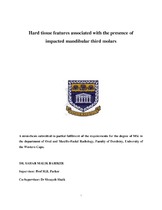| dc.contributor.advisor | Parker, M.E. | |
| dc.contributor.advisor | Shaik, Shoayeb | |
| dc.contributor.author | Babiker, Sahar Malik | |
| dc.date.accessioned | 2017-10-02T12:45:15Z | |
| dc.date.available | 2017-10-02T12:45:15Z | |
| dc.date.issued | 2016 | |
| dc.identifier.uri | http://hdl.handle.net/11394/5604 | |
| dc.description | >Magister Scientiae - MSc | en_US |
| dc.description.abstract | Different pathology associated with impacted wisdom teeth in the oral cavity showed that it is prevalent and may lead to varied dental complications. This study adopted a descriptive cross-sectional retrospective analytical design in order to examine hard tissue features associated with the presence of impacted third molars in a random sample of 2998 digital panoramic radiographs (DPRs) of patients' records in Tygerberg Oral Health Centre, Faculty of Dentistry, University of Western Cape. The specific objectives of the study were to categorize the type of impactions in the DPRs of patients and to determine the prevalence of distal cervical caries (DCC) in second molars, any radiolucent (RL) /radiopaque (RO) lesions or external root resorption (ERR) complications associated with impacted wisdom teeth. Results of the pantomographs and clinical records of patients indicated that the most prevalent type of impaction (TOI) is Mesioangular (MA) Impaction (65%) followed by Horizontal (H) Impaction (17%), Vertical (V) Impaction (15%), Transverse (TVS) Impaction (2 %) and Distoangular (DA) Impaction (1.2 %), respectively. The least prevalent type was Inverted (INV) Impaction with a frequency count of 0.5%. The results further indicated varied dental complications resulting from impaction, ranging from ERR with a frequency of 3% of which 66.70% was associated with MA type of impaction, followed by H with a frequency of 26.7%. The association of Gender and RL/ RO lesions was significant (p-value=0.04) while association between DCC and types of impaction was also significant (p-value =0.0017). The study concluded that the high prevalence of MA among all populations and genders over the years may be related to the anatomical normal inclination of the third molars to the mesial surface. The low prevalence of DA observed in the study sample on the other hand might be attributable to gender and demographic factors. Lastly, this study has only one radiopaque lesion and the high prevalence of RL lesions in males and in the older age group suggests that these complications take a while to develop. Future research is needed to raise more awareness and encourage patients to seek treatment of symptomatic and asymptomatic third molars before complications arise. | en_US |
| dc.language.iso | en | en_US |
| dc.publisher | University of the Western Cape | en_US |
| dc.subject | Digital panoramic radiographs | en_US |
| dc.subject | Distal cervical caries | en_US |
| dc.subject | External root resorption | en_US |
| dc.title | Hard tissue features associated with the presence of impacted mandibular third molars | en_US |
| dc.rights.holder | University of the Western Cape | en_US |

